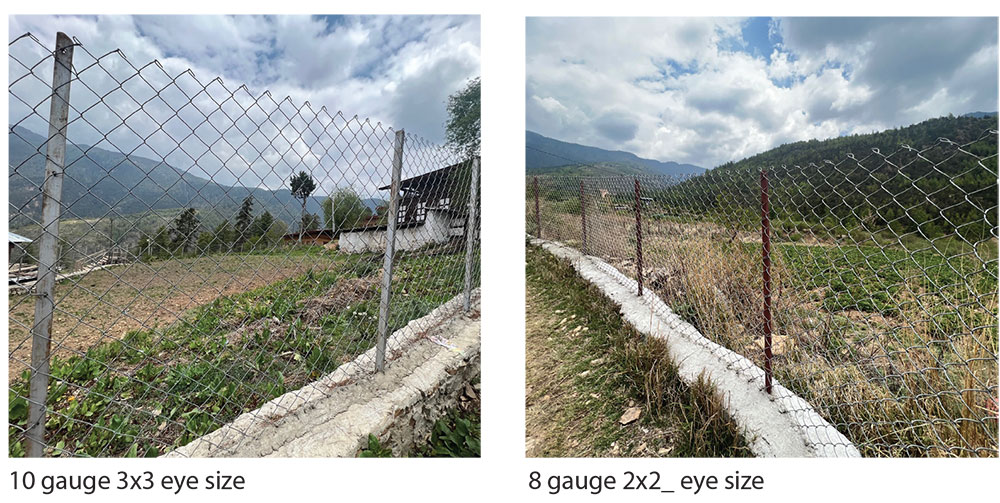… calls for inspection of materials supplied at site
Rinzin Wangchuk
The government’s e-GP system for procurement of goods, works and services, suppliers claim, is not fool-proof and the system is breeding “corrupt practices” and “ambiguity” in the tendering process.
While there had been some complaints before, this time it is from the local wire mesh or chain-link manufacturers after the government rolled out the first phase of chain-link fencing projects worth Nu 174 million in all the 20 dzongkhags. The project is ongoing and expected to complete within this fiscal year.
To curb the emerging human-wildlife conflict (HWC) and enhance food security, the government initiated to provide chain-linked fencing to farmers across the country.
Local manufacturers said that the system is abused through systemic manipulation, thereby deceiving both the government and the chain-link beneficiaries – farmers.
A bidder claimed that he had not even seen tenders being floated in some dzongkhags. The finance ministry on July 4 last year issued a notification that the e-GP system was rolled out in 205 gewogs but it seems few dzongkhags have not followed or respected in both letter and spirit.
“Could this be some breach of the tenet of transparency?” a supplier said. The e-GP was rolled out to ensure transparency, effectiveness, accountability and operational efficiency processes.
One wire mesh manufacturer, who wishes to remain anonymous, said that the chain-link tenders seem to be planned in such a way that some tenders are kept online for just three to four days as a formality, depriving potential bidders of adequate time to participate. “Some bidders are getting prior information on how long the tender would remain uploaded in the e-GP system, “ he said.
Another said that when they enquired about the system, officials give lame excuses like system failure, connectivity issues and power failure. “Selective bidders were informed about the quantity of the material required which is often not mentioned in the open tender,” he claimed.
Bidders said that it was important for them to know the quantity of materials required as the volume of business is an important factor in determining the cost or the rate.
“When the total quantity or volume of work is not mentioned in the open tender, it gives room for manipulation of tender processes,” he said.
Some bidders also claimed that the current tendering process favouring the low-quoted bids is becoming an ideal breeding ground for corrupt practices. “This is because the specifications and quality standards are ignored taking due advantage of the systemic loopholes,” one said, adding that doing quality checks at the site while receiving goods would ensure that the technical specifications and quality standards are not compromised.
Suppliers are calling on responsible agencies to investigate the first phase of tender processes and the materials delivered at the site before the second phase tender is rolled out. “If an investigation is done and actions taken immediately it would send a big message to all other people who are involved in corrupt practices starting from evasion of tax at the entry gate and supplying low-quality materials to innocent farmers,” one said.
In his earlier clarification to Kuensel, Agriculture and Livestock Minister Yeshey Penjor said that the quality of materials and specifications are all set and monitored by dzongkhag engineers. He had said that both the local and international suppliers across the border are all governed by the rules and procurements are done by the dzongkhag tendering committees as per the specification provided. “The ministry at the centre has no hands in procurement procedures,” Lyonpo Yeshey Penjor had said during the 49th Meet the Press.
Quality/specifications compromised?
As per the government’s specification, suppliers are required to supply chain-link with a standard wire gauge of 8 swg (gauge), mesh eye size of 2”x2” (inches). Some suppliers alleged that traders, who won the chain-link tenders by quoting low rates, have reportedly supplied chain-link with compromised eye size 3”x3”.
One bidder, who won tenders in two dzongkhags, reportedly quoted Nu 340 per square meter (m2) for 2”x2”. Local manufacturers said that since the rate quoted is far below the cost of production both in India and Bhutan, it is absolutely impossible for them to supply at this rate unless they play or manipulate the quantity or the quality parameters and other technical specifications. When one trader quoted Nu 340 per m2 the rate in Jaigaon was Nu 420 excluding 10 percent tax required to pay at the point of entry.
One supplier from Jaigaon told Kuensel that he supplies chain-linked 8swg 2”x2” for Nu 365 and Nu 301 for 3”x3” per m2 which means the total cost price with 10 percent entry tax comes to Nu 401.5 and Nu 331.1 respectively.
According to bidders, the 3”x3” eye size costs 50 percent lower than 2”x2” eye size. “When the eye size or the opening of chain-linked wire mesh is larger, it weighs less and also costs less,” one supplier from Phuentsholing said.
The proprietor of Jurmed Phendhey Wire Netting in Shaba, Nima, said that he had recommended the dzongkhags administration in Paro, Wangduephodrang, Gasa, Samtse, Sarpang and Tsirang dzongkhags where he supplied the fencing materials to choose the 3”x3” eye size chain-linked material. “It is cost-effective and covers more kilometres,” he said, adding that he also supplied 3”x3” materials in Tsirang and a few dzongkhags as per their specifications.
The ministry has identified chain-linked fencing as a major solution to tackle increasing cases of HWC and allotted Nu 500M in the current fiscal area. It is expected that the first phase project will cover 119km in 20 dzongkhags, 3,000 acres of cultivated land and benefit 937 households.


